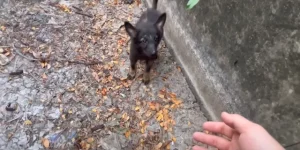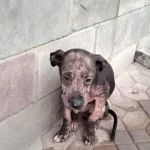
In a world typically marred by indifference, a compassionate particular person crosses paths with Pup, a hopeful German Shepherd pet. This serendipitous encounter sparks the genesis of a unprecedented alliance.
Moved by empathy, the person decides to rewrite Pup’s future. He extends a comforting hand to the frightened, forsaken pet, ushering him right into a realm of benevolence and care.
Because the solar rises and units, the bond between the person and Pup deepens, blossoming right into a relationship steeped in mutual understanding and affection. Their shared journey weaves a tapestry of treasured recollections.
Beneath the person’s nurturing care, Pup’s power prospers, and their dwelling transforms right into a sanctuary radiating heat. The person’s unwavering persistence guides Pup in the direction of a newfound sense of safety and acceptance.
The person turns into the architect of Pup’s holistic well-being, guaranteeing a balanced eating regimen and fascinating playtime actions. By means of optimistic reinforcement coaching methods, Pup masters self-discipline and obedience.
ten tips for feeding dogs :
- Choose High-Quality Dog Food: Opt for dog food that is specifically formulated for your dog’s age, size, and health needs. Look for options with whole meat sources as the primary ingredients and avoid fillers like corn and soy.
- Follow Feeding Guidelines: Different dogs have different nutritional requirements based on their age, weight, activity level, and health condition. Always follow the feeding guidelines provided by the dog food manufacturer or your veterinarian.
- Provide Fresh Water: Ensure your dog has access to clean, fresh water at all times. Hydration is essential for digestion, nutrient absorption, and overall health.
- Stick to a Feeding Schedule: Establish a consistent feeding schedule for your dog. Most adult dogs do well with two meals a day, while puppies may need three or four smaller meals. Consistency helps regulate their digestion and prevents begging behavior.
- Avoid Table Scraps: While it may be tempting to share your food with your dog, many human foods can be harmful to them. Avoid feeding table scraps, especially those containing onions, garlic, chocolate, grapes, or raisins, as these can be toxic to dogs.
- Monitor Portion Sizes: Overfeeding can lead to obesity and other health issues, while underfeeding can result in nutritional deficiencies. Monitor your dog’s body condition and adjust portion sizes as needed to maintain a healthy weight.
- Consider Treats Carefully: Treats should only make up a small portion of your dog’s daily caloric intake. Choose healthy, low-calorie treats, or use pieces of your dog’s regular food as rewards during training sessions.
- Be Mindful of Special Dietary Needs: Some dogs may have special dietary needs due to allergies, sensitivities, or health conditions. Consult with your veterinarian if you suspect your dog has specific dietary requirements.
- Watch for Signs of Food Allergies: Common signs of food allergies in dogs include itching, gastrointestinal upset, ear infections, and skin problems. If you suspect your dog is allergic to their food, consult your veterinarian about switching to a hypoallergenic diet.
- Gradually Transition to New Foods: When introducing a new food or making changes to your dog’s diet, do so gradually over the course of about a week. This helps prevent digestive upset and allows your dog’s system to adjust to the new food.
By following these tips, you can ensure that your dog receives the proper nutrition to support their overall health and well-being.



